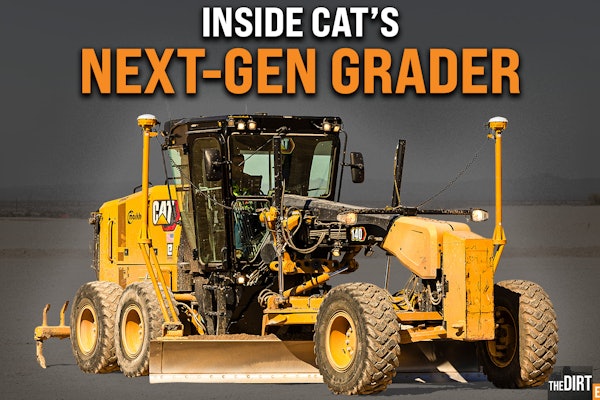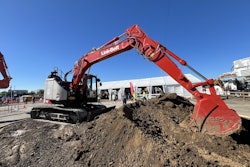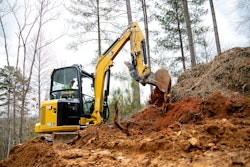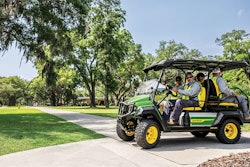Concrete mixer trucks are highly specialized trucks. To ensure maximum productivity and long service life, it’s important to spec them properly. A large part of this process is weight management, according to Brian Lindgren, market segment manager for vocational and off-highway trucks at Kenworth.
He says that the first criteria you must meet when spec’ing a new mixer truck is your local length and weight regulations, since these will dictate the axle spacing and wheel spacing needed to maximize payload. Many states, particularly in the Western United States, require compliance with federal bridge formula restrictions, placing further limitations on how axles are set up and spaced.
“Bridge formula trucks tend to be longer to spread the vehicle weight out more,” Lindgren says. “In states where you don’t need to comply with the bridge formula, you can spec trucks shorter and heavier. These trucks are more maneuverable on jobsites, but you may need to spec lift axles to handle the extra weight they carry.”
When spec’ing for bridge formula configurations, in many cases you will need to request a booster axle at the rear of the truck to increase the weight allowed. All told, according to Lindgren, you need at least 427 inches from the centerline of the front steer axle to the centerline of the booster axle to insure the truck will qualify for a 36-foot bridge.
“At the same time,” he notes, “you need to stay within the 40-foot overall truck limit length. To meet this demand, the steer axle needs to be as far forward as possible, usually right up against the bumper.” Lindgren also cautions against spec’ing a long, permanently mounted tow hook. “It could extend out far enough to make the truck over length,” he says.
Tires are another important consideration – regardless of whether the mixer is a bridge formula model or not. Depending on the weight carried by the truck’s steer axle and the laws in your state, you may also need to spec wide-based front tires. In states where tire footprints are regulated, a typical footprint is rated at 600 pounds per inch of tire width. If that’s the case, you’ll require a much wider tire – perhaps a 425/65R22.5 – to handle 20,000 pounds on the front two tires.
You can also save weight – sometimes as much as 400 pounds – by looking at the truck’s suspension. “And you can also leave off rear shock absorbers since the weight of the mixer means the truck will never be running light,” says Al Zwicky, applications engineer, Peterbilt. “And using a large single frame rail is lighter than using a double frame rail and also eliminates the risk of corrosion between rail and liner.”
Another weight saving strategy is to use aluminum crossmembers, Zwicky notes. “You can save up to 25 pounds per crossmember without affecting the durability or integrity of the frame assembly,” he says.
“When considering weight saving ideas, there is usually a trade-off,” cautions Adam Ference, manager, vocational segments, Western Star. “Don’t specify weight saving components that could compromise the integrity or longevity of the vehicle, or its safe operation. Weight savings always look good on paper, but remember that a mixer is a work truck in a severe application.”
How to cut even more pounds from the platform
Saving weight is always a plus when spec’ing a mixer. The lighter the truck, the more concrete it can carry – directly affecting your bottom line. But if you want the truck to haul another half yard of concrete, you’re going to have to look for innovative ways to reduce the truck’s overall weight. A good way to do this is to consider using lightweight components wherever possible.
Many standard vehicle components such as wheels, air tanks and clutch housings can be spec’d with aluminum instead of steel. Lindgren also advises selecting an aluminum cab. It’s not only going to be lighter, but more corrosion resistant too.
“Use the smallest fuel tank you can get away with,” Lindgren says. “Most mixer trucks burn approximately 4 to 4 1/2 gallons an hour. So a 55- or 60-gallon tank usually has plenty of fuel for one shift working locally.”
Consider using wide-base “super single” tires instead of duals on the rear of the truck. This option can potentially save you hundreds of pounds in wheel and tire weight. But, Lindgren says, there’s a trade-off. “You get a narrower track if you stick with standard track axles,” he explains. “Some drivers feel this is a less stable configuration when driving on the highway. You can go to wider track axles, but you may not have the option to revert to duals later on.”
Bear in mind though, Ference says, that using super single tires will change the mixer’s center of gravity. “If the truck’s center of gravity changes dramatically, you might have to reconsider the use of some components to get back to a safe operating platform,” he says.
Consider location and environment
Where you expect to be delivering concrete will also have an influence on your mixer’s specs. The heavier the load and the rougher the terrain, the more you will need to beef up the truck’s chassis and suspension. Mixers can get into some rough jobsites, so be sure to spec a suspension with a lot of articulation. Look for a balance of articulation, ride, durability and low weight.
Location also translates into traction concerns. Areas with sandy soil, such as Florida, will require spec’ing trucks with 6-by-6 (all-wheel) drive to prevent bogging down. “Lately I’ve seen ready-mix contractors spec’ing six-by-four configurations with active tire pressure control systems,” Lindgren says. These systems allow your driver to reduce tire pressure when they’re off-road to get needed traction in sand or mud. The tires can be re-inflated from the cab when pulling back onto the road.
“Chassis height is also a consideration for two reasons,” observes Zwicky. “First, the mixer body must be able to fit beneath the charge hopper. Second, the lower the frame height, the lower the center of gravity is, which results in better vehicle stability.”
Another thing to remember about operating off-road is the engine’s air filtration requirements. If your mixers routinely operate in dry, dusty conditions, use a pre-cleaner to remove large contamination particles before they reach the air filter.
Mixer frames must be strong
The frame provides a mixer with its inherent strength. But the type of mixer barrel used affects frame rail specifications. If the mixer barrel has a subframe welded to the chassis rails that is approved by an OEM, Lindgren says a single 11-5/8-inch frame is fine. “But you’ll want a transition plate bolted to the frame at the back of the cab which goes as far forward as possible to ease the stress on the rails,” he comments.
If the mixer pedestals are mounted directly to the frame rails, you’ll need an inserted frame of at least 10-3/4 inches. “Remember,” Lindgren says, “it’s not just strength you’re looking for in your frame rails, but stiffness too. And if you have more than one pusher axle, you should have an inserted rail to withstand the higher side loads the axles generate.”
A final note about mixer frames: Always remember mixer suppliers often request crossmembers in specific locations to accommodate their bodies. It’s a good idea to check on these locations before your truck is built.
Horsepower is not always king
High horsepower is not a requirement for mixer applications, Lindgren says. You should get just enough horsepower in the truck to do the job at hand. Generally speaking, 300 to 350 horsepower is plenty for most mixers. Extra horsepower just uses more fuel, puts more strain on the rest of the drivetrain and adds cost up front.
To get the best performance and feel from your mixer’s steering, Lindgren recommends spec’ing dual steering gears rather than a single steering gear with an assist ram. A dual system usually requires less maintenance over time than a single, assisted system while delivering positive steering input and response.
If your mixer is equipped with lift axles, it’s smart to spec the truck with a six-channel ABS system. Lift axles, especially steerable ones, are normally over-braked for the load, Lindgren explains. “By including them in the ABS system, they’re less likely to lock up and will help to reduce tire flat spotting.”
Ference says Western Star recommends that whenever possible, lift axles should be ordered from the chassis manufacturer. “That way, they can be installed on line to the manufacturers exact standards and qualify for OEM warranty coverage,” he says.
Mixer powertrains perform difficult roles
Mixer transmission demands are more complex. A mixer transmission needs a lot of ratio range to ensure you have a low enough gear to inch along when placing concrete and a high enough top gear to attain and maintain decent highway speeds.
Manufacturers report they are starting to see more automatic transmissions being spec’d for mixers. The new electronic controls on these units allow them to be as fuel efficient as manual units, and they’re easier on drivers and reduce stress on the truck’s drivetrain. The only downside: they cost more up front.
A mixer truck’s PTO must come directly from the engine in order to provide enough power for the mixer system. Whether you use a front-PTO or rear-engine PTO depends on the chassis configuration. Whenever possible, Lindgren recommends using rear engine PTOs. “Front-engine PTOs affect the truck’s cooling system,” he explains. “And the PTO pump is generally out front in a vulnerable position. The PTO’s hydraulic lines have to snake past the engine – often close to the exhaust system – to get back to the mixer drive motor. Rear engine PTOs usually make for a cleaner installation.”
But in some areas of the country where the front pedestal must be mounted immediately back of the cab, a front-engine PTO is your only option. “That’s the case in Florida,” Lindgren says. “State laws there give you an incentive to get more load on the front axle. Mounting the PTO up front is an easy way to do that.”
If you spec an automatic transmission for your mixer, Lindgren says you definitely want a rear-mounted PTO because it will provide 30 percent higher output speed due to the gearing at the flywheel. This, in turn, allows much less slip in the torque converter when the truck is crawling along and you want to keep the drum speed up to pour the concrete. Too much slip in a torque converter can lead to overheating the transmission or engine’s cooling system.
Match your rear axle ratios with the transmission so that engine speed is around 1,600 rpm at highway speeds. “You should also be able to go as slow as 1 1/2 mph at 1,400 rpm or more,” Lindgren comments. “A 4:30:1 or slower ratio with 11R22.5 tires and an Eaton Fuller-9ALL manual transmission usually work well together. With a six-speed automatic transmission, use a 4:88:1 or slower ratio.”










